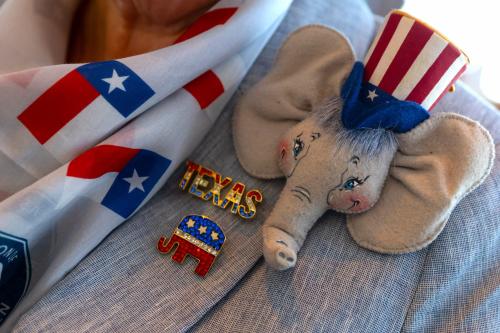Throughout Bernie Sanders’s presidential campaigns in 2016 and 2020, he promised to transform the Democratic Party and American politics. He promised a “revolution” that would resonate with a powerful group of Americans who have not normally participated in politics: young voters, liberal voters, and new voters. He believed that once his call went out and their voices were heard, millions of these new voters would swell the ranks of the progressive wave, transforming the Democratic Party and America.
So far, Bernie Sanders has failed.
His promise to build a new coalition has not come to fruition, and that failure has largely knocked him out of frontrunner status in the Democratic nomination contest. And while supporters of Senator Sanders will point to their social media feeds and their groups of friends and to the attendance at rallies, the numbers don’t lie. Exit polling (and for caucuses, entrance polling) shows that Mr. Sanders has not changed the Democratic electorate in a significant way, and in fact, has seen key setbacks in the precise groups he has said he would deliver on.
In 12 of the early primary and caucus states, there is consistent exit polling between the 2016 and 2020 Democratic primaries. Examining three key Sanders constituencies—young voters, liberal voters, and first time voters—tells the story of Sanders’s struggle thus far.
Among young voters—those 17 to 29—in those 12 states, their share of the electorate dropped between 2016 and 2020 in 11 of those states. Sanders was able to increase young voters only in Iowa. Some of these decreases were significant and in surprising places. Young voters’ share of the electorate decreased by six percent in New Hampshire; five percent in Texas; and four percent in South Carolina, Alabama, North Carolina, Tennessee, and Vermont. Sanders won New Hampshire and Vermont by far smaller margins than he did in 2016. In 2016, Sanders received 60 percent of the youth vote in New Hampshire and 86 percent of their vote in Vermont. In 2020, that dropped to 36 percent in New Hampshire and 51 percent in Vermont.
These decreases in young voters’ share of the electorate stand in stark contrast to the promises to grow that voting block and its power. Even a stagnant percentage between 2016 and 2020 would present a challenge for Mr. Sanders, but a decrease poses a serious challenge to the very premise of his campaign.
These demographic challenges do not stop with young voters. Voters who identify as liberal and very liberal have shrunk as a share of the Democratic primary electorate in several states. The table below shows the changes between 2016 and 2020 among Democratic primary voters who identify as liberal or very liberal. In 10 of the 12 states, the percent share of the electorate composed of people who identify as very liberal dropped between 2016 and 2020. That number increased in only Texas. Similarly, the share of voters who identify as liberal decreased in 9 of the 12 states, increasing in 2 (Oklahoma and North Carolina), and remaining the same in 1. For Senators Sanders, this presents a real challenge. He is a hero to the progressive left, and one of the most liberal individuals in recent history with a serious chance of becoming a major party nominee. His views, positions, and record have inspired a number of people to back the call for revolution. However, that undeniable energy has not translated into liberal and very liberal voters increasing their share of the electorate—even in the Democratic primary.
| Very Liberal/Liberal Voters as a Share of the Democratic Primary Vote, 2016-2020 | ||||
| 2016 | 2020 | |||
| Very Liberal | Liberal + Very Liberal | Very Liberal | Liberal + Very Liberal | |
| Iowa | 28 | 68 | 25 | 68 |
| New Hampshire | 26 | 68 | 21 | 61 |
| Nevada | 33 | 70 | 31 | 67 |
| South Carolina | 23 | 54 | 19 | 50 |
| Alabama | 27 | 57 | 22 | 54 |
| Massachusetts | 29 | 70 | 27 | 64 |
| North Carolina | 26 | 56 | 23 | 59 |
| Oklahoma | 18 | 45 | 18 | 49 |
| Tennessee | 25 | 61 | 24 | 58 |
| Texas | 20 | 59 | 24 | 57 |
| Vermont | 33 | 74 | 29 | 65 |
| Virginia | 29 | 68 | 19 | 53 |
| Source: CNN Exit Polling | ||||
The final group of voters who Mr. Sanders promised he would energize and empower in the 2020 election were new voters. This effort makes some sense. In a period in which a non-trivial number of voters are turned off by both parties and have been for a while, Mr. Sanders advances the theory that there is a group of silent voters who could come out of the woodwork for the right candidate and cause a seismic shift in America’s political landscape. Thus far, however, new voters have not dominated the Democratic primary—in fact, they, too, have largely shrunk or stayed the same since 2016.
As the chart below shows, among the 10 states thus far with comparable exit polling, first time voters have composed a smaller share of the electorate in 6 states, remained the same in 2, and increased in 2. In the two states in which first time voters increased as a share in the electorate between 2016 and 2020, Tennessee saw a one-point increase (14% to 15%) and South Carolina six points (13% to 19%). The challenge for Mr. Sanders is that while there was a significant increase in the share of new voters in South Carolina, former Vice President Joe Biden won 33% of them; Sanders captured only 26%.
In sum, there is no evidence so far to suggest that Sanders has been able to mobilize large numbers of young voters, liberal voters or new voters. However, there are some caveats to these data that are important to address. First, exit and entrance polling can be imprecise. Errors in process can exist and margins of error are meaningful and vary among states. However, one can assume there will be similar imprecision and challenges within the same state over two election cycles, meaning that changes (or stability) are more accurate than the absolute numbers.
Second, we unfortunately do not have comparable polling data in every state between 2016 and 2020. Most notably, CNN did not have exit polling in California or Colorado in 2016—two states Senator Sanders won in 2020. Although the data listed above do include states Mr. Sanders won in 2020 (Nevada, New Hampshire, Vermont), understanding the dynamics that powered a significant win in Colorado and a solid win in California would be important. Yet, despite the absence of those two states, Mr. Sanders’s failure to increase the voting power of these key groups in a dozen states remains real and meaningful.
Third, there is a difference between the percent share of an electorate and turnout. Turnout among the groups mentioned above could increase significantly, while the percent share of the electorate remains the same or even decreases. However, if these voting blocs are going to have such a transformative and revolutionary role in the 2020 election, they must have an outsized role relative to other voting blocs.
Fourth, this analysis is not meant to lay blame entirely at the feet of Senator Sanders. His message should be an effective one for many of the key voting blocs that he seeks to drive to the polls, but the reality in America is that voting can be difficult. In some areas that difficulty is increasing because of a variety of voter access/suppression laws. In many areas young people (and especially students), new voters, new Americans, and others face real challenges in terms of the ability to vote. These barriers, in many cases, are beyond the control of a candidate. A campaign can seek to overcome them, but structural and institutional barriers can be powerful. However, if a revolution is going to be realized, it needs to be able to overcome any of those barriers, and thus far, the Sanders campaign has not found a way.
The struggles the Sanders campaign has faced, particularly with the key groups mentioned above, must be reversed if Mr. Sanders is to become the Democratic nominee for president. However, those struggles are not only his. Young voters, new voters, and liberal voters are important elements to a Democratic coalition. Whoever is the Democratic nominee—whether it is Mr. Biden or Mr. Sanders—must not only appeal to those groups but turn them out. If Mr. Sanders is unable to do this in a Democratic primary, the implications for Mr. Biden in a general election are even more dire.



Commentary
Bernie Sanders’s failed coalition
March 10, 2020